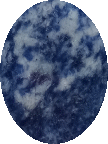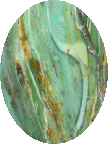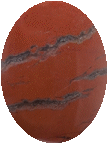| |
Jasper
|
The name jasper can be traced back to the Hebrew jashpth (ישפה) possibly meaning spotted stone, though some sources claim the Hebrew name is borrowed from the Assyrian ashpu. In either case it means that the word Jasper is one of the oldest continually used names for a precious stone. Jasper is an opaque variety of chalcedony, or cryptocrystalline quartz with impurities. Jaspers and chalcedonies, also called agates, make up the two branches of the largest family of gemstones. In jaspers the color and pattern of the stone dictate its properties and virtues.
The term jasper has historically been a catchall term used to describe a number of colorful opaque stones. This historical blending of taxonomy causes some confusion because extended the name jasper to include stones that we would call agates. It was also used interchangeably for sards and related materials, as well as low grade stones that were normally crystalline such as the opaque emerald. The bloodstone is a specific type of jasper that is often described in detail in many historical lapidaries. Such jaspers that are described specifically enough to be identified as separate stones will be listed under their modern classifications.
The folkloric properties of the jasper were derived both from the visual appearance of the stone and the engravings upon it. Many lapidaries recommend combining specific engravings with jaspers of similar properties to increase the power of the amulet. It should be noted that in many of the lapidaries there are recommendations to have the amulet blessed, and to abstain from sexual contact while wearing it.
|
| Blue Jasper - | Only a couple of lapidaries mention blue jasper, and bestow upon it the ability to create an amulet to control the weather and summon storms. This may be because blue jasper is somewhat rare and often mistaken for other materials. Most of the blue jasper encountered today is dyed. True blue jaspers do exist such as the spotted verity, but these are often mistaken for lapis, chrysocolla, or azurite in spite of being much harder. However, I suspect that the historical lapidaries are actually referring to a blue aventurine based on the descriptions given.
Many other lapidaries bestow the rain bringing property on the green jasper instead of the blue, which is very rarely mentioned.
|
| Green Jasper - | Considered the most valuable in most historical lapidaries. There may be some confusion with the opaque emerald, which would have been thought of as separate stone form an emerald do to visual differences. This stone was said to imbue the wearer with courage and honor, make him charismatic and powerful, and banish frivolity. An amulet of green jasper would counteract poison and was especially powerful if engraved with a scorpion when the sun was in the House of Scorpio. Silver jewelry set with this stone, banished phantoms, mended the sight, protected from madness, and helped with issues with the stomach and bowels.
In the American south there is a certain green jasper was much sought after by cunning folk and traditional healers as it was said to draw the disease out of a person. When this occurred the green of the stone was said to gain a yellow tint or fade. The color, as well as the good, of the stone could be restored once more by letting it set in sunlight for a time.
|
| Red Jasper - | This stone was said to warm the blood, and stop hemorrhaging. This is an interesting material because where later lapidaries say the stone helps during childbirth, the earlier ones warn against it being worn by women because it would keep them from getting pregnant, and would “throw out the baby dead or alive”. |
|
Colors
|
Various colors and patterns
|
Locations
|
Jasper is found worldwide.
|
Compisition
|
SiO2, opaque cryptocrystalline quartz
|
Hardness
|
6 - 7
|
|

|

|

|
|
|
|
|
|